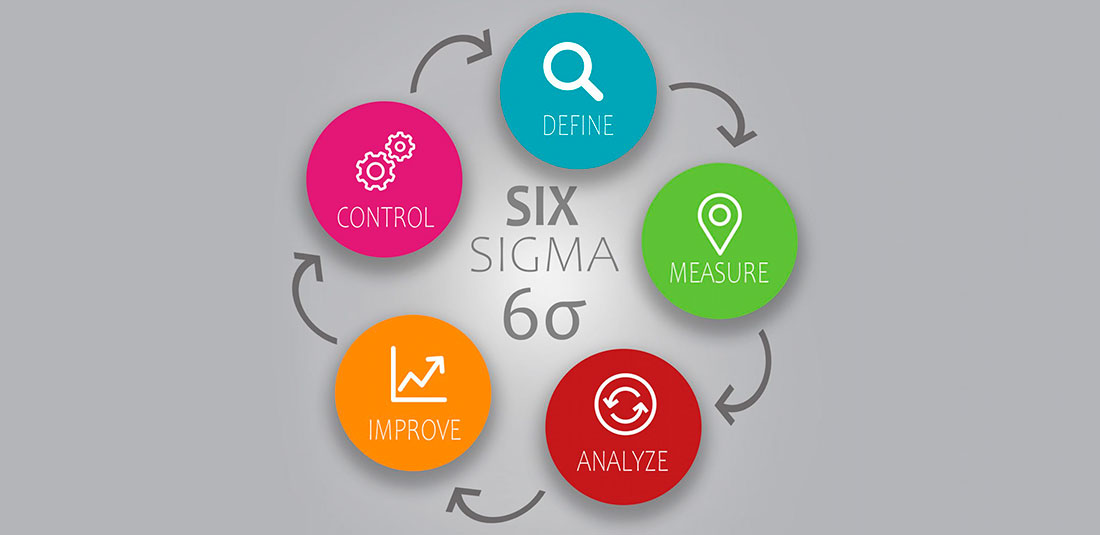Six sigma methodology, basic principles

The main goal of project management is to achieve the planned goal without exceeding the budget. For this purpose, it is important to organize all work processes correctly and minimize the number of errors and defects. Various techniques and tools can be used for this purpose. For example, the concept of “Six Sigma”, focused on users and accuracy of indicators. This method appeared in the 80s, was developed by Motorola Corporation, and in the 90s became the key strategy of General Electric. The technique is based on the “philosophy of lean thinking”. What does this technique represent? What advantages and disadvantages does it possess? How does it help in project management? Let’s try to understand.
What is Six Sigma

This term is related to the Lean methodology aimed at optimizing work processes. The concept of Lean manufacturing was formed after World War II, in Japan. The 6 Sigma methodology was first used by Motorola Corporation to combat manufacturing defects. Both of these approaches are used together to improve work processes.
Sigma is a letter of the Greek alphabet denoting a standard deviation from the norm. In probability theory, the 6 Sigma approach is expressed by the formula: no more than 3.4 defects per million operations. At Motorola, this principle was used to measure the errors allowed in the product manufacturing process. The 6 Sigma system consisted of six levels, each with a certain number of defects:
| Sigma level | Number of deficiencies (non-compliance with customer requirements) |
|---|---|
| 6 | 1 |
| 5 | 2 |
| 4 | 3 |
| 3 | 4 |
| 2 | 5 |
| 1 | 6 |
The Six Sigma concept focuses on the customer, his satisfaction with the final result of the work. It requires mandatory standardization of the service or product. Any deviations from the established norms should be minimal. The number 6 in this case is conditional. You can define for yourself any number of quality levels. They can be 12 or, for example, 4. But, according to the developers, this is the distribution of deviations that corresponds to the majority of processes. In accordance with this gradation, the business of the sixth level is considered the most successful, and the first – unprofitable.
Basic principles of the Six Sigma methodology
The six sigma methodology is based on three postulates:
- Customer orientation, customer orientation. The company should strive to meet the needs of consumers. It is on the basis of their interests and needs that its strategy is formed.
- Management of all work processes. They should be standardized and formalized.
- Formation of team spirit. All project participants: from the director to the service staff should contribute to the company’s development and strive for its prosperity. All team members are united by a common goal and help each other to achieve it.
Other principles of the Six Sigma concept:
- Making decisions based on concrete facts and real data.
- Implementation of the process approach in production.
- Calculating the possible consequences of each decision.
- Justified risk-taking to achieve better results.
Pros and cons of the methodology
Like any other management techniques, Six Sigma has strengths and weaknesses. Its strengths include:
- Versatility. It can be used to improve any process.
- Systematization of data to enable efficient analysis of information.
- Progressive problem solving through a process approach.
- Outcome Orientation.
- Management tools and techniques are integrated into a single system.
Disadvantages of technology:
- It is suitable only for companies with authoritative management, and requires strict personnel management.
- Does not allow changes in management style or corporate culture of the company. The main objective of the methodology is to reduce the number of defects. It does not take into account the possibility of improving planning or production.
Six Sigma algorithms and tools

The concept uses two approaches united by the principle: “Plan-Do-Do-Check-Correct”. The DMAIC algorithm is aimed at improving production processes, while the DMADV or DFSS technique is used for new product development.
DMAIC algorithm
- D – Define. Formulate project objectives based on customer needs. Select a team, assign roles and areas of responsibility among the participants.
- M – Measure. Clarify what the client wants. Prepare the necessary information, identify the “key” points and processes of the project.
- A – Analyze. Based on the analysis of the information obtained, identify the factors affecting the quality of work. Identify the main causes of defects. Develop methods for their elimination.
- I – Improve. Optimize existing processes. Start with trial changes.
- C – Control. Control all the edits you make to avoid new defects. Keep track of statistics, inform project participants about all changes. Duplicate the process until the process is stable.
This algorithm implies working ahead of the curve. Changing consumer preferences must be predicted in advance, preventing defects from appearing. It is easier to prevent them than to eliminate them.
DMADV algorithm (DFSS)
It stands for Define – Measure – Analyze – Design – Verify.
- Project goals are set based on the company’s strategy and the desires of potential customers. A working team is formed.
- The main characteristics of the future product are outlined.
- Various options for producing the product are selected and analyzed.
- Among them choose the best option, get to work.
- The product is validated with pilot tests before launch.
The following tools are used to implement 6 sigma technology in manufacturing processes:
Business process maps
These are diagrams depicting the resources available to the team and its actions.
Benefit-cost analysis (CBA)
The ratio between the costs and the expected benefits of the project is assessed.
CTQ tree
This is a diagram that shows the critical quality indicators. It is used at the initial stages of a project to clarify the requirements for a product or service.
Planning the experiment
This tool is used to prepare for the experiments.
Statistical methods
These include the Schuchart control chart, the Pareto curve, and other tools.
Distribution of roles in the team

Teamwork and high employee involvement are necessary conditions for successful implementation of the 6 sigma methodology. In order for it to work smoothly and in an organized manner, the team must be properly assembled and trained. For this purpose, the Japanese philosophy of hierarchical organization of society is used. Participants of work processes are divided by seniority. The team respects more experienced senior colleagues who occupy the highest position in the hierarchy, and they, in turn, are leaders and mentors for subordinates. Roles in such a team are distributed as follows:
- White and yellow belts are beginners doing a narrow scope of work in a project.
- Green Belts are small group leaders, generating ideas, implementing the methodology in the processes assigned to them.
- Black belts are team leaders, controlling yellow and green belt performers, training them, leading them to success.
- Masters – supervise Black Belts, assist them in concept realization, and participate in dispute resolution.
- Sponsors or champions – monitor the achievement of goals, seek resources for them, identify what projects or processes need to be improved.
- Leaders are the top managers or senior executives who are best versed in the methodology, creating the necessary conditions to implement Six Sigma in production.
An example of Lean Six Sigma implementation in practice
To demonstrate the effectiveness of this management concept, here are some examples of large companies that use 6 sigma in their work:
- The author of the Six Sigma concept is Bill Smith, an employee of the quality management service of Motorola Corporation. Before the introduction of this technology, up to 10% of the company’s annual revenue was spent on eliminating the consequences of defects in production. As a result of its application, the corporation saved more than 16 billion dollars in revenue from 1986 to 2001.
- The Six Sigma system has been used at Ford since 2000. Thanks to the methodology, the automaker’s revenue increased by 300 million dollars. In addition, the company has created several successful projects that have been appreciated by the brand’s customers.
- Boeing Airlines has been training specialists in the 6 sigma methodology since 1999. In the five-year period since the program’s introduction, its costs have decreased by $210 million.
According to statistical observations, in 2007, 82 of the top 100 segment-leading companies in the United States switched to Six Sigma. Over the next 4 years, they realized an additional 4% to 7% increase in profits.
Here’s what it looks like in practice:
A company manufacturing cabinet furniture sold 1,000 units of sets during the year. 40 items were returned because of defects in the design. 15 products were rejected by the store due to incompleteness. 25 users left negative feedback about the low quality of components. In total, the company received 80 complaints for 1000 units of products:
- 40 critical, resulting in direct costs (refunds);
- 25 averages (reviews) affecting the demand of a product;
- 15 minor (understaffing) – their elimination did not entail large costs.
They are assigned the following points:
Critical – 3; significant – 2; marginally significant -1.
Calculate their total weight:
40х3+25х2+5х1 = 185 points.
In the second and third phases of DMAIC, 6 more “critical locations” were identified. As a result, the total sum of defects is: 1,000x(1+2+3+12) = 18,000 points. The share of defects in the volume of furniture produced: 185/18,000×100% = 1.02%.
This deviation approaches sigma level 3. That is, the company operates inefficiently.
LeaderTask for project management

Various digital systems and tools are successfully used to organize project management. With their help, it is easier to organize interaction between participants in a team. Optimize all processes in the production of goods or services. Minimize errors and costs by controlling activities at every stage. LeaderTask is one of such services that replaces several programs used for strategic, current planning and project management. The application has a full set of various options for effective teamwork. It can be used to set goals, control their achievement, create assignments and tasks, and delegate them to other executives.
In the program you can exchange information, discuss any project issues in the corporate chat room, track the progress of each performer. Identify possible bottlenecks in a timely manner. Control the consumption of time and other important resources. The application has a convenient calendar for planning, the necessary tools for working according to the GTD methodology, the Pareto principle, flexible Agile and Scrum technologies. LeaderTask synchronizes with various digital platforms and does not require an internet connection.
Conclusion
The Six Sigma concept is aimed at finding defects and their causes. For this purpose, statistical, experimental research and systematic quality management are used. Successful implementation and use of the methodology depends on the competence of project managers and their competent interaction with other project participants.
Practical experience of large foreign companies has shown that one manager with “black belt” qualification can realize 5-6 projects per year. One such specialist can save the company up to 175 thousand dollars, increasing its profit per year to 1 million.



